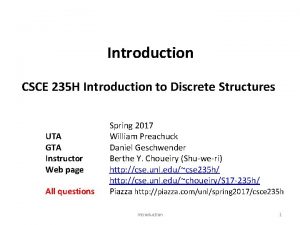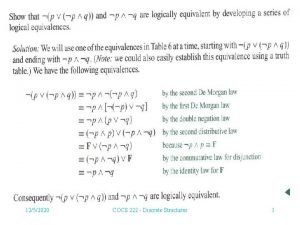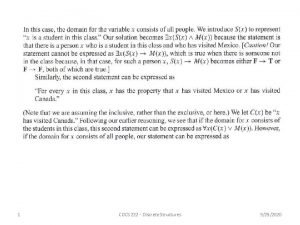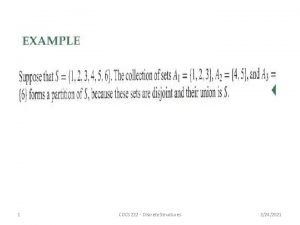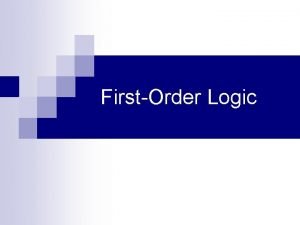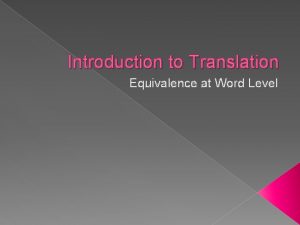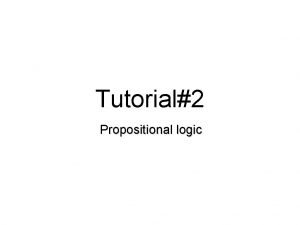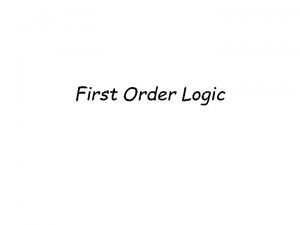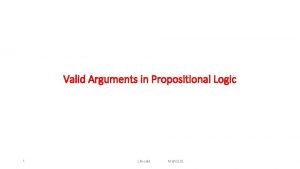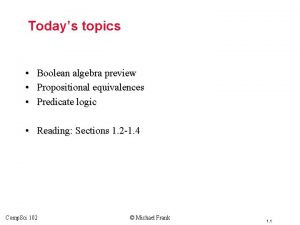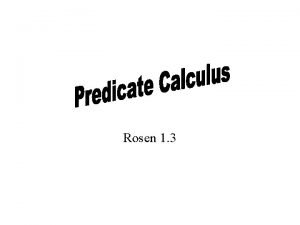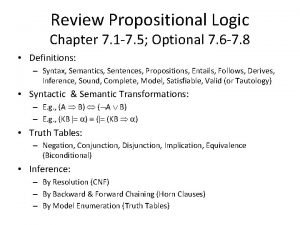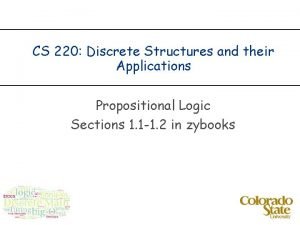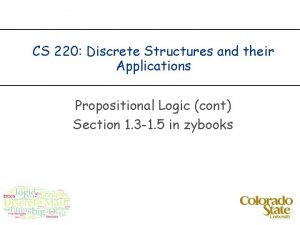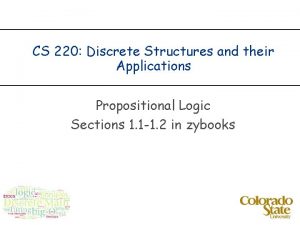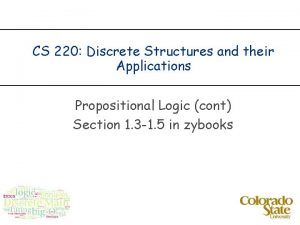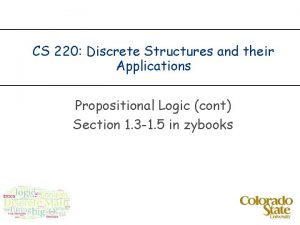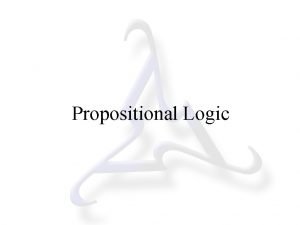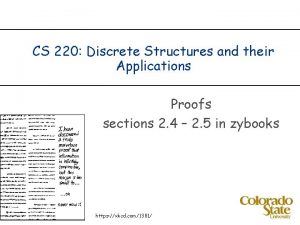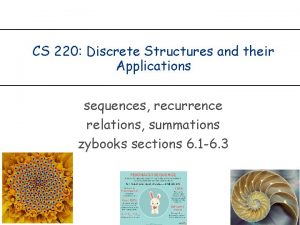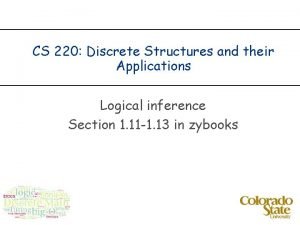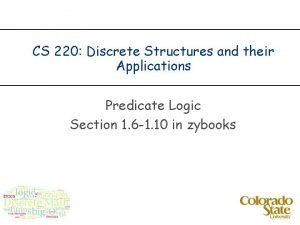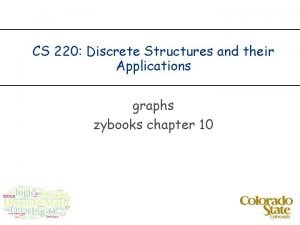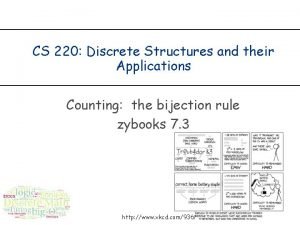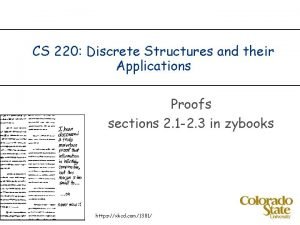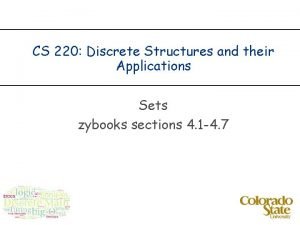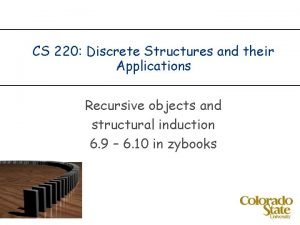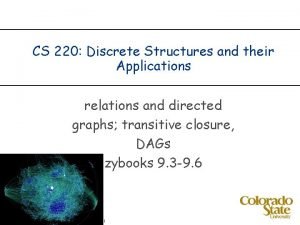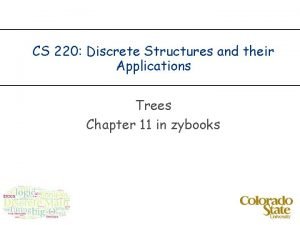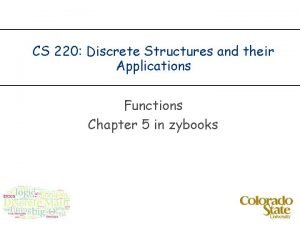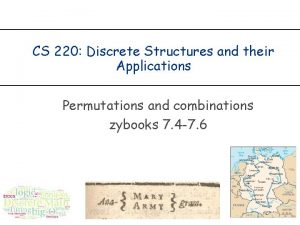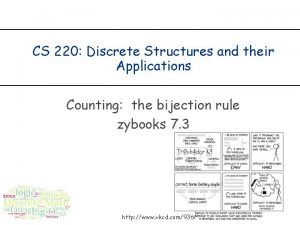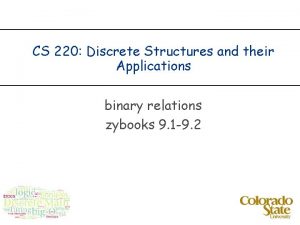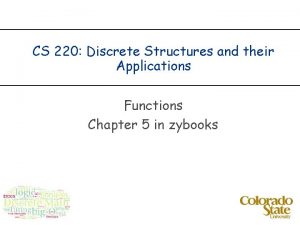CS 220 Discrete Structures and their Applications Propositional
























- Slides: 24

CS 220: Discrete Structures and their Applications Propositional Logic (cont) Section 1. 3 -1. 5 in zybooks

Conditional statements The conditional statement p q means “p implies q” or “p is sufficient for q” This is different from an if statement! The expression “p implies q” is true if p = false or q = true p q is the same as p q Why? Build the truth table for p q p q T T F F F T T F F T

Conditional statements To help understand conditionals think of them as an obligation or contract, e. g. : n If I am elected, taxes will be lowered (taxes may become lower even if I’m not elected) The only way for the contract to be broken is that I get elected and taxes won’t be lowered. p q T T F F F T T F F T

Conditional statements in English p: You mow Mr. Smith's lawn. q: Mr. Smith will pay you. If p, then q. If you mow Mr. Smith's lawn, then he will pay you. q if p. Mr. Smith will pay you if you mow his lawn. p implies q. Mowing Mr. Smith's lawn implies he will pay you. p only if q. You will mow Mr. Smith's lawn only if he pays you. p is sufficient for q. q is necessary for p. Mowing Mr. Smith's lawn is sufficient for him to pay you. Mr. Smith's paying you is necessary for you to mow his lawn.

The converse, contrapositive, and inverse A few statements related to p → q: v The converse of p → q is q → p. v The contrapositive of p → q is ¬q → ¬p. v The inverse of p → q is ¬p → ¬q. p q T T F F F T T F F T One of the three is equivalent to the original conditional, WHICH ONE? How do you know?

The converse, contrapositive, and inverse A few statements related to p → q: v The converse of p → q is q → p. v The contrapositive of p → q is ¬q → ¬p. v The inverse of p → q is ¬p → ¬q. p q T T F F F T The contrapositive is equivalent to the original conditional. The converse and inverse are equivalent to each other.

Biconditionals The biconditional statement p q means “p if and only if q” or “p iff q” p q has the same truth value as p q q p p q T T F F F T

Conditionals and operator precedence Conditionals have lower precedence than conjunction and disjunction. Operator precedence: 1. Negation 2. Conjunction 3. Disjunction 4. Conditional 5. Bi-conditional

Logical equivalence Compound propositions that have the same truth values in all cases are called logically equivalent Example: p q ≡ p q p q p p q p q T T F T T T F F F T T T

Equivalence of propositions using truth tables p q q p p q T p q q p T T T F F F T T The last two columns have the same values, so the propositions are logically equivalent

Tautology and Contradiction v v v A tautology is a compound proposition that is always true. A contradiction is a compound proposition that is always false. A contingency is neither a tautology nor a contradiction.

Examples p p T F F T T F Which is a tautology and which is a contradiction?

Logical equivalence revisited Compound propositions that have the same truth values in all cases are called logically equivalent Propositions s and r are logically equivalent if and only if the proposition s r is a tautology.

De Morgan’s Laws: Very useful for logical reasoning and manipulating logical statements! Example: p: The patient has migraines q: The patient has high blood pressure De Morgan's law says that the following two English statements are logically equivalent: It is not true that the patient has migraines or high blood pressure. The patient does not have migraines and does not have high blood pressure.

Equivalence of (p q) and p q Proof of logical equivalence using a truth table: p q p q p q (p q) p q T T F F T T F F T T

Idempotent laws: Associative laws: Commutative laws: Distributive laws: Identity laws: Domination laws: Double negation law: Complement laws: p p ≡p ( p q ) r ≡p ( q r ) p q ≡q p p ( q r ) ≡( p q ) ( p r ) p F ≡p p T ≡p p F ≡F p T ≡T ¬ ¬p ≡ p p ¬p ≡ F p ¬p ≡ T ¬F ≡ T ¬T ≡ F De Morgan's laws: ¬( p q ) ≡ ¬p ¬q Absorption laws: p (p q) ≡ p Conditional identities: p → q ≡ ¬p q ≡( p → q ) ( q → p )

The distributive law (p q) q r p (q r) p q p r (p r) p q r F F F F F T F F F F T T T T F F F T T T F F T T T

More equivalences for conditionals/biconditionals

Biconditional equivalence p q (p q) p q T T T F F T T F F

Simplifying propositions using laws of propositional logic Prove that: ¬(p q) (¬p q) ≡ ¬ p Proof. ¬(p q) (¬p q) ≡ (¬p ¬q) (¬p q) ≡ ¬p (¬q q) ≡ ¬p T ≡ ¬p De Morgan’s law distributive law complement law identity law

Using equivalences to prove new facts prove: is a tautology by 1 st De Morgan law by the commutative law by the negation law

English to Logic Consider the propositions: n n n p – Grizzly bears have been seen in the area q – Hiking is safe on the trail r – berries are ripe along the trail Translate from English to logic: n Berries are ripe along the trail, but grizzly bears have not been seen in the area

English to Logic Consider the propositions: n n n p – Grizzly bears have been seen in the area q – Hiking is safe on the trail r – berries are ripe along the trail Translate from English to logic: n If berries are ripe along the trail, hiking is safe if and only if grizzly bears have not been seen in the area

English to Logic Consider the propositions: n n n p – Grizzly bears have been seen in the area q – Hiking is safe on the trail r – berries are ripe along the trail Translate from English to logic: n Hiking is not safe on the trail whenever grizzly bears have been seen in the area and berries are ripe along the trail
 Propositional logic puzzles
Propositional logic puzzles Discrete math propositional logic
Discrete math propositional logic Homologous structures example
Homologous structures example Absorption law
Absorption law 2110200
2110200 What is discrete math
What is discrete math Discrete computational structures
Discrete computational structures Discrete structures
Discrete structures Cs 584
Cs 584 Discrete structures
Discrete structures Discrete mathematics with applications susanna s. epp
Discrete mathematics with applications susanna s. epp Pros and cons of propositional logic
Pros and cons of propositional logic Translation
Translation Word level equivalence
Word level equivalence Propositional logic examples and solutions
Propositional logic examples and solutions Logical operators in r
Logical operators in r N-ary relations
N-ary relations Expander graphs and their applications
Expander graphs and their applications Application of solid insulating material
Application of solid insulating material Arguments in logic
Arguments in logic Propositional equivalences
Propositional equivalences Propositional network
Propositional network Propositional function examples
Propositional function examples Propositional logic examples
Propositional logic examples Proposition in mathematics
Proposition in mathematics





